Chuck Wilson (pilot)
Charles Paul Wilson II (born November 22, 1953) is a retired United States Air Force colonel who is notable for his work in political-military affairs, national security policy, defense acquisition, and business development. He commanded four different military units at the squadron and wing organizational levels. Wilson performed operational testing of the prototype S1034 pressure suit and flew the first operational mission of the Lockheed U-2S spy plane. He is a rated US Air Force command pilot with over 3,800 flight hours.
Charles Wilson II | |
|---|---|
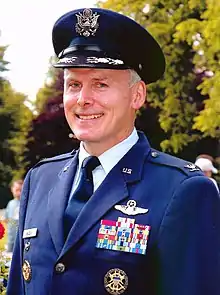 Wilson at a Memorial Day ceremony in May 2005 | |
| Nickname(s) | Chuck |
| Born | November 22, 1953 Indianapolis, Indiana |
| Allegiance | United States |
| Service/ | United States Air Force |
| Years of service | 1977–2004 |
| Rank | Colonel |
| Commands held | Air Force Command and Control Training and Innovation Group 5th Reconnaissance Squadron 4402nd Reconnaissance Squadron 6510th Air Base Group Headquarters Squadron |
| Battles/wars | Cold War Gulf War |
| Awards | Defense Superior Service Medal Legion of Merit Defense Meritorious Service Medal |
After retiring from the Air Force, Wilson worked as a business executive in the aerospace industry. He is a docent at the National Air and Space Museum, author, and a frequent military aviation speaker. Wilson is active in veterans' affairs and has made significant contributions including serving in leadership roles of increasing responsibility.
Early life and education
Wilson was born November 22, 1953, in Indianapolis, Indiana[1] and was the first of three children born to Charles Wilson Sr. and Mary Wilson. He grew up in Indianapolis where his father was a World War II combat veteran and an engineer for General Motors Corporation and his mother was a homemaker.[2] Wilson went to Saint Michael's Grade School and graduated from North Central High School. Wilson also graduated from Culver Military Academy summer schools. He earned a Bachelor of Science Degree from Indiana University (IU).[1] While at IU, Wilson worked at United Parcel Service (UPS) at night unloading trucks, sorting packages, and was promoted into UPS management. Later, Wilson earned a Master of Science degree from Embry–Riddle Aeronautical University (1985), graduated from the United States Army Command and General Staff College, the Armed Forces Staff College (now the Joint Forces Staff College), the Air War College, and was the 1997 National Defense Fellow and author of Strategic & Tactical Air Reconnaissance in the Near East.[3][4][5]
Military career

During his freshman year at Indiana University, Wilson, entered the Air Force Reserve Officer Training Corps (AFROTC) as a pilot candidate and completed the Air Force flight instruction program with a private pilot license. With the drawdown of US forces in Vietnam, Air Force pilot production was minimized with AFROTC pilot candidate slots for active duty virtually eliminated.[6] Instead, Wilson was commissioned a second lieutenant, and in 1977, received orders to Port Austin Air Force Station in Michigan where he was posted as the chief of administration and personnel.[1]
In 1980, Wilson was selected as commander of the 6510th Air Base Group (ABG) Headquarters Squadron, responsible for base services including personnel, public affairs, and security,[7] where he achieved the Air Force Flight Test Center's "Executive Officer of the Year" award. Wilson was subsequently selected for Undergraduate Pilot Training (UPT) at Reese Air Force Base, Texas. After completing UPT, Wilson was assigned to fly the KC-135Q Stratotanker that refueled the SR-71 Blackbird.[1] The Q-model KC-135 aircraft was specially configured to dispense the JP-7 fuel required by the SR-71.[8]
U-2 Dragon Lady
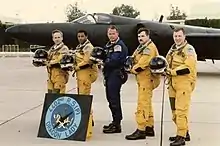
In 1986, Wilson was selected to fly the Lockheed U-2 Dragon Lady, a high altitude reconnaissance aircraft. During the Cold War, he served on multiple operational deployments flying missions over contested areas of the world.[9][10] Wilson advanced to flight instructor in the U-2 and in 1993 commanded the 4402nd Reconnaissance Squadron (Provisional), known as the Desert Dragons, at Taif Air Base, Saudi Arabia.[1][11]:354 A provisional squadron is one created for a limited time to accomplish a specific mission.[12] The 4402nd was formed to continue reconnaissance operations over Iraq after the end of the 1991 Gulf War in order to ensure compliance with United Nations (UN) resolutions.[13]:312 U-2s from the 4402nd flew Olive Branch missions to provide imagery for the United Nations Special Commission (UNSCOM) that searched for evidence of Iraqi weapons of mass destruction.[13]:312[14]:178 The Iraqi government did not approve of these overflights, and Wilson's first U-2 mission for the UN was targeted by Iraqi anti-aircraft weapons. The U-2s operating in-theater at this time had outdated defensive capabilities. Wilson's mission report was instrumental in obtaining funding for the "Band Aid" upgrades to the U-2's defensive systems.[13]:313 The U-2 flies at altitudes where the air pressure is too low for an unprotected person to survive. During his tour with the 4402nd, Wilson performed operational testing of the prototype S1034 pressure suit manufactured by the David Clark Company to evaluate its suitability in the U-2.[11]:354
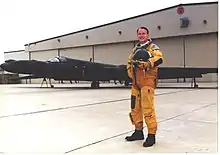
In 1995, Wilson was assigned command of the 5th Reconnaissance Squadron, known as the Blackcats, that operated from Osan Air Base, South Korea.[15] The squadron received the U-2S[16] with an upgraded General Electric F118-101 engine that provided significant weight and fuel savings over the previous Pratt & Whitney J75 engine.[13]:315[17] On October 20, 1995, Wilson flew the first U-2S operational mission.[16] Under Wilson's leadership, the 5th Reconnaissance Squadron received the 1995 Lockheed Advanced Development Corporation (Skunkworks) "Hughes Trophy," distinguishing the unit as the best reconnaissance squadron in the 9th Reconnaissance Wing that year. The 5th RS was also nominated for the Republic of Korea Presidential Unit Citation.[16]
Promoted to colonel in 1997[18], Wilson was assigned as the commander of the Air Force Command and Control Training and Innovation Center (AFC2TIC) at Hurlburt Field, Florida. The center of excellence was renamed as the Air Force Command and Control Training and Innovation Group (AFC2TIG) in April 1999 and renamed again in 2004 as the 505th Command and Control Wing. Wilson's organization re-engineered airpower command and control (C2) at the operational level of war. Air Operations Centers worldwide were restructured with trained staff, standardized equipment, and worked with a deliberate process that is used across the globe.[19] The team trained warfighters of different experience levels. On short notice and at the direction of the chief of staff, AFC2TIG trained every active duty Air Force general officer on the Theater Battle Management Core System.[20] Wilson led and managed this group of over 3,000 personnel and 13 disparate Air Force units located across the United States.[21]
Pentagon assignments
In 1993, Wilson served on the Joint Staff of the Joint Chiefs of Staff (JCS) at the Pentagon in Arlington, Virginia.[1] During this time, review and approval for peacetime reconnaissance operations was performed using the JCS "book process" and coordinated by the Reconnaissance Operations Division (ROD) within the J3 Operations Directorate.[22]:132–3 As Chief of Air Reconnaissance Plans and Programs[1], also known as the "book officer", Wilson was the principle focal point for acquiring National Command Authority and National Security Council approval for sensitive reconnaissance missions worldwide. In this position, he was also the advisor to the United Nations for Airborne Reconnaissance.[22]:132–3
In 1997, Wilson was selected for the Office of the Secretary of Defense as the Chief of Manned Reconnaissance in the Defense Airborne Reconnaissance Office (DARO), and in 1998, Deputy Director for Airborne Intelligence Surveillance and Reconnaissance Programs in the Office of the Assistant Secretary of Defense (Command, Control, Communications and Intelligence), or ASD(C3I), to oversee defense acquisition of air reconnaissance systems.[1] ASD(C3I) was replaced by the Assistant Secretary of Defense for Networks and Information Integration, or ASD(NII) in May 2003.[23]:20
Department of State
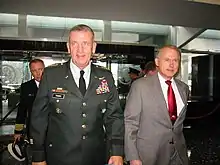
In 2001, Wilson transitioned to military roles that interacted with the Department of State. Assigned as the deputy director of the Office of Contingency Planning and Peacekeeping within the Bureau of Political-Military Affairs, he was the senior Air Force advisor at the State Department. Shortly after the September 11 attacks, Wilson was promoted to director of the Office of International Security Operations (ISO)[1] that provided the Department of Defense's primary interface with the Department of State on operational military situations.[24]:24 As ISO director, he was the senior US military representative to the Department of State.[1] To support the around-the-clock war-time tempo, Wilson designed and implemented Political Military Action Teams (PMATs) that became the State Department's point of contact for military operations on the Global War on Terror.[24]:23[25]
Wilson oversaw ISO activities that included obtaining clearances for US cargo aircraft to enter the airspace of other countries, refueling at foreign airports, coordinating diplomatic efforts to establish bases in the countries bordering Afghanistan, and eventually supporting US embassies efforts to base US forces in coalition nations.[24]:24[26]
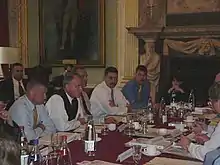
In 2002, Wilson led the US delegation in the annual United States/United Kingdom Political-Military talks to discuss access to the British-owned island of Diego Garcia.[27] Wilson and British Indian Ocean Territory commissioner, Alan Huckle, reached agreement to add shelters for the B-2 Spirit bomber as well as upgrade existing infrastructure. B-2 facilities on Diego Garcia would allow the bombers to be based much closer to potential targets in the Asia-Pacific region reducing round-trip flight time from their Missouri bases from 50 hours to approximately 15.[28] Two of the B-2 shelters were completed at Naval Support Facility Diego Garcia by the end of 2002 and two additional shelters were added in 2005.[29]
One of Wilson's priorities as ISO director was providing information to Defense and State leadership.[30] This task required he and his staff support visits to the State Department by senior military officers.[31] These efforts were helpful and appreciated as demonstrated when USCENTCOM commander, General Franks, visited to personally meet and thank members of the ISO coalition team.[24]:24
With 27 years of service, Wilson retired from the Air Force in December 2004 with over 3,800 flying hours in the T-37, T-38, KC-135A, KC-135Q, TR-1, and U-2.[32]
Later years
After retirement, Wilson worked in the aerospace industry at Raytheon as the senior corporate business development lead for air intelligence programs.[33] He also worked for L-3 Communications’ Wescam/Sonoma Electro Optic (EO) imaging systems as a director of business development for airborne intelligence, surveillance, and reconnaissance (ISR) sensors.[33] Wilson was also an aerospace consultant with the Goyak Group[34] specializing in national security, foreign policy, and business development.[35]

Wilson remains active in the aerospace community as a volunteer for a number of organizations. He is a docent and military aviation lecturer at the Smithsonian National Air and Space Museum's (NASM) Steven F. Udvar-Hazy Center annex at Washington Dulles International Airport in Virginia.[3] In 2016, he spoke at Freedom Museum in Manassas, Virginia about his USAF career as a U-2 pilot.[36] In 2017, Wilson appeared in the documentary, The Dragon Lady, from the Smithsonian Channel’s Air Warriors series of videos.[37][38] In 2019, he was elected chairman of The Cold War Museum’s Board of Directors.[3][39][40] Wilson is a member of the Order of Daedalians[41] and in 2019 served as chaplain of Daedalian Flight 4, the National Capital Flight, in Fort Myer, Virginia.[42]
In veterans' affairs, Wilson has served in increasingly responsible leadership roles. In 2015, Wilson commanded the Veterans of Foreign Wars (VFW) Hawkins-Reeve Post 7916[43] where he was awarded "All State" and "All American" honors recognizing exceptional leadership and accomplishment in membership growth and participation in key programs.[33] On February 23, 2016, Wilson addressed the Senate of Virginia to stress the importance of House Bill 63 that would bring Virginia law in accordance with Federal law by exempting veteran service organizations from local taxation. House Bill 63 was approved by the Virginia assembly and signed into law by the governor.[44] Later in 2016, Wilson was elected chairman of the Potomac Region Veterans Council where he represented over 15,000 veterans in 29 veteran service organizations.[34] In 2017, Wilson transitioned to commander of Virginia District 10,[45] where he again achieved "All State" and "All American" honors.[33]
As of 2015, Wilson and his wife, Judy, have four children and four grandchildren.[43]
Awards and decorations
Wilson was awarded the following decorations for his military service. Based on his assignments, he was also authorized to wear the Office of the Secretary of Defense Identification Badge and Air Force Commander Badge.[1][32]
 | ||
 | ||
Other achievements
The US Department of State twice selected him for the Superior Honor Award for leadership in the Global War on Terror, Operation Enduring Freedom, and Operation Iraqi Freedom. The United Way honored Wilson twice with their "Citizen of the Year" award.[1]
Notes
- "Colonel Charles P. Wilson II". Washington, D.C.: United States Department of State. June 2004. Archived from the original on March 8, 2005. Retrieved February 19, 2020.
- "Obituary, Charles P. Wilson Sr". The Indianapolis Star. December 29, 2004. p. 19.
- "Past Occoquan VFW commander now leads The Cold War Museum". Potomac Local. Potomac Local Media LLC. December 2, 2019. Retrieved February 5, 2020.
- Wilson II, Charles P. (1999). Strategic and Tactical Aerial Reconnaissance in the Near East. Washington, D.C.: Washington Institute for Near East Policy. ISBN 0-944029-31-0. Retrieved February 8, 2020.
- "ERAU Alumni Class Notes". Daytona Beach, Florida: Embry-Riddle Aeronautical University. December 2019. Retrieved March 20, 2020.
- F-4 Phantom II Society (Illustrated ed.). Turner Publishing Company. 2001. p. 91. ISBN 978-1563116384. Retrieved March 20, 2020.
at this time (mid-1970s), most (USAF ROTC) pilot candidates were not getting Undergraduate Pilot Training slots
- "History of the Air Force Flight Test Center, Volume 1, January through June 1961, K286.69-37" (PDF). United States Air Force. 1962. pp. 6–8. Retrieved March 17, 2020.
- Graham, Richard (1996). SR-71 Revealed: The Untold Story (First ed.). Zenith Press. pp. 38–39. ISBN 0760301220.
- "Sharing the Cold War Story" (PDF). Cold War Times. Vint Hill, Virginia: Cold War Museum. Spring 2016. p. 6. Retrieved April 26, 2020.
Chuck Wilson, a Cold War U-2 pilot and U-2 squadron commander ... flew many critical Cold War missions over hostile territory
- "'The Lost Black Cats' Exclusive Premiere at VFW Post 7916". Occoquan, Virginia: Veterans of Foreign Wars Post 7916. May 22, 2019. Retrieved April 26, 2020.
Colonel Chuck Wilson, later day Black Cat Commanding Officer and Cold War U-2 pilot
- Jenkins, Dennis R. (2012). Dressing for Altitude: U.S. Aviation Pressure Suits—Wiley Post to Space Shuttle (PDF). National Aeronautics and Space Administration. ISBN 978-0-16-090110-2. Retrieved February 15, 2020.
- "Provisonal unit"". thefreedictionary.com. Farlex, Inc. Retrieved February 10, 2020.
- Pocock, Chris (2005). 50 Years of the U-2: The Complete Illustrated History of the "Dragon Lady". Atglen, Pennsylvania: Schiffer Military History. ISBN 978-0-7643-2346-1.
- Norris, Pat (2010). Watching Earth from Space: How Surveillance Helps Us – and Harms Us. Springer Science & Business Media. ISBN 978-1-4419-6938-5.
- "5 Reconnaissance Squadron (ACC)". Air Force Historical Research Agency. United States Air Force. July 31, 2019. Retrieved February 7, 2020.
- "5th Reconnaissance Squadron". Osan Air Base. United States Air Force. February 26, 2007. Retrieved February 7, 2020.
- "U-2S/TU-2S Fact Sheet". United States Air Force. September 23, 2015. Retrieved February 8, 2020.
- CY97 Colonel Central Selection Board – Selectees. United States Air Force. 1997. p. 9.
- "505 Command and Control Wing (ACC)". Air Force Historical Research Agency. United States Air Force. March 27, 2012. Retrieved February 12, 2020.
- "TBMCS General Officer Training". Command and Control (C2) News. United States Air Force. 2 (2): 7. Spring 2001.
- "Commander's Corner". Command and Control (C2) News. United States Air Force. 2 (2): 1. Spring 2001.
- Santucci, Joe (2013). The Lens of Power: Aerial Reconnaissance and Diplomacy in the Airpower Century (PDF). Maxwell Air Force Base, Alabama: Air University. Retrieved February 22, 2020.
- "Department of Defense Key Officials" (PDF). Historical Office, Office of the Secretary of Defense. June 2014. Retrieved February 22, 2020.
- Tucker, Doug (April 2002). "Political-Military Bureau Supports 'Enduring Freedom'" (PDF). State Magazine. Washington, D.C.: United States Department of State. Retrieved March 3, 2020.
- "Political-Military Action Team (PMAT)". Washington, D.C.: United States Department of State. 2002. Retrieved March 9, 2020.
- "ISO Director Col. Charles Wilson". Washington, D.C.: United States Department of State. September 2002. Retrieved March 3, 2020.
- "U.S./U.K. Political-Military Talks". Washington, D.C.: United States Department of State. September 2002. Retrieved March 3, 2020.
- Sand, Peter H. (2009). United States and Britain in Diego Garcia: The Future of a Controversial Base. Hampshire, England: Palgrave MacMillan. p. 117. ISBN 978-1-349-38028-2.
- "B-2 Shelter System [B2SS] Extra Large Deployable Aircraft Hangar Systems (Formerly: B-2 Shelter Program)". GlobalSecurity.org. Archived from the original on April 14, 2013. Retrieved March 7, 2020.
- "Department of State Visits by Senior Military Officers". Washington, D.C.: United States Department of State. September 2002. Retrieved March 3, 2020.
- "Colonel Charles Wilson Escorts General Tommy Franks". Washington, D.C.: United States Department of State. January 8, 2003. Retrieved February 21, 2020.
- Biography of Colonel Charles P. Wilson II. United States Air Force. September 2004.
- "Charles P. 'Chuck' Wilson Biography". Veterans of Foreign Wars District 10. July 14, 2017.
- "Potomac Region Veterans Council gets new chairman". Potomac Local. Potomac Local Media LLC. October 28, 2016. Retrieved March 10, 2020.
- "VFW Honors Virginia District Commander". princewilliamliving.com. July 30, 2018. Retrieved March 10, 2020.
- "Colonel Charles 'Chuck' Wilson to Speak at the Freedom Museum". Potomac Local. Potomac Local Media LLC. June 14, 2016. Retrieved March 10, 2020.
- Pocock, Chris (July 11, 2017). "Air Warriors Video Documentary". dragonladytoday.com. Retrieved February 20, 2020.
- "U-2 Dragon Lady". Air Warriors. The Smithsonian Channel. May 28, 2017. Retrieved February 20, 2020.
- "Former pilot leading Cold War Museum board". whatsupwoodbridge.com. December 3, 2019. Retrieved February 5, 2020.
- "U-2 pilot elected chairman of Cold War Museum board". fauquiernow.com. December 4, 2019. Retrieved February 5, 2020.
- "JROTC Awards" (PDF). Daedalus Flyer. Randolph AFB, Texas: Daedalian Foundation. Spring–Summer 2017. p. 17. Retrieved March 11, 2020.
4th Flt: Col. Charles P. Wilson, USAF (Ret) presents the JROTC Achievement medal to AF JROTC Cadet Caroline Humphreys
- "Flight 4 – Flight Officers Gallery". Apollo Daedalian Portal. Randolph AFB, Texas: Order of Daedalians. 2019. Retrieved March 11, 2020.
- "Chuck Wilson, Commander, VFW Post 7916". Veterans of Foreign Wars Post 7916. September 23, 2015. Archived from the original on August 23, 2015. Retrieved March 10, 2020.
- "HB 63 Passes Virginia General Assembly". The Virginia Veteran. April 2016. p. 3. Retrieved March 13, 2020.
- "Occoquan VFW Post 7916 celebrates new leadership, honors outgoing Commander". What's Up Prince William. May 16, 2017. Retrieved March 10, 2020.
Attribution
 This article incorporates public domain material from the United States Air Force website https://www.af.mil.
This article incorporates public domain material from the United States Air Force website https://www.af.mil. This article incorporates public domain material from the Air Force Historical Research Agency website http://www.afhra.af.mil/.
This article incorporates public domain material from the Air Force Historical Research Agency website http://www.afhra.af.mil/. This article incorporates public domain material from websites or documents of the United States Department of State.
This article incorporates public domain material from websites or documents of the United States Department of State.
External links
| Wikimedia Commons has media related to Chuck Wilson (USAF U-2 pilot). |
- "30th Anniversary Celebration of the Black Cats". Blackbirds.net. December 2, 2006. Retrieved March 10, 2020.
- Appearances on C-SPAN
- "Blackbird Association Newsletter" (PDF). Habu.org. March 2015. Retrieved March 12, 2020.
- "Colonel Charles P. Wilson II". Blackbirds.net. March 25, 2004. Retrieved February 7, 2020.
- Webster, Amanda (June 13, 2016). "Colonel Charles 'Chuck' Wilson to Speak at the Freedom Museum". Realtor Association of Prince William. Woodbridge, Virginia. Retrieved February 22, 2020.
- Wilson II, Charles P. (November 28, 2016). "The Desert Dragons". slideshare.net. LinkedIn Corporation. Retrieved February 19, 2020.
- Wilson II, Charles P. (December 21, 2016). "US-UK Bilateral Talks at DGAR Brief-1". slideshare.net. LinkedIn Corporation. Retrieved March 17, 2020.
- Wilson II, Charles P. "U-2 Mission". area51specialprojects.com. Retrieved February 11, 2020.
- Wilson II, Charles P.; McKinley, James (April 12, 2005). "History of the Dragon Lady and the 5th Reconnaissance Squadron 'The Blackcats'". taiwanairpower.org. Retrieved February 19, 2020.